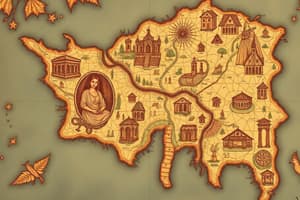Podcast
Questions and Answers
What is a map projection?
What is a map projection?
A systematic projection of all or part of the surface of a round body, especially Earth, on a plane.
Which of the following is not a classification of map projections based on the developable surface?
Which of the following is not a classification of map projections based on the developable surface?
- Cylindrical
- Ellipsoidal (correct)
- Conical
- Planar/Azimuthal
What type of projection is the Mercator projection?
What type of projection is the Mercator projection?
- Cylindrical (correct)
- Conical
- Planar
- None of the above
What are the variants of map projections based on aspect?
What are the variants of map projections based on aspect?
Conformality in map projections means that the shapes of small features on the Earth are distorted.
Conformality in map projections means that the shapes of small features on the Earth are distorted.
What does equivalence mean in map projections?
What does equivalence mean in map projections?
Flashcards are hidden until you start studying
Study Notes
Map Projections
- Map projections transform the spherical Earth surface onto a flat plane, utilizing mathematical methods.
- Different map projections correspond to various developable surfaces: Cylindrical, Conical, and Planar/Azimuthal.
Classifications of Map Projections
- Cylindrical Projections: Extend from the Equator and are best for navigation; e.g., Mercator Projection.
- Conical Projections: Suitable for mid-latitude regions; preserve shapes over small areas.
- Planar/Azimuthal Projections: Useful for specific points; project the surface from a singular viewpoint.
Variants of Map Projections
- Variants include different perspectives and applications like Normal, Transverse, and Oblique aspects that influence how maps present geographic information.
- Viewpoints of projections can drastically change the representation of regions on the map.
Properties of Map Projections
- Conformality: Preserves shapes of small features. Useful for navigation as scale and direction remain true over small areas.
- Equivalence (Equal Area): Maintains proportional area representation, useful in area calculations and statistical mapping.
- Equidistance: Retains scale over specific lines or points, enabling accurate distance measurement from designated locations, as seen in Equidistant Cylindrical projections.
Geographic to Grid Conversion
- Involves systematic processes to transform geographic coordinates into grid coordinates.
- Critical for various applications like GPS technology.
Grid to Geographic Conversion
- The reverse process of converting grid coordinates back to geographic positions.
- Essential for mapping services and location-based applications.
Meridian Convergence
- Describes how meridians converge toward the poles, affecting distance and direction on maps.
- Important for understanding distortion in map projection, especially near polar regions.
Studying That Suits You
Use AI to generate personalized quizzes and flashcards to suit your learning preferences.




